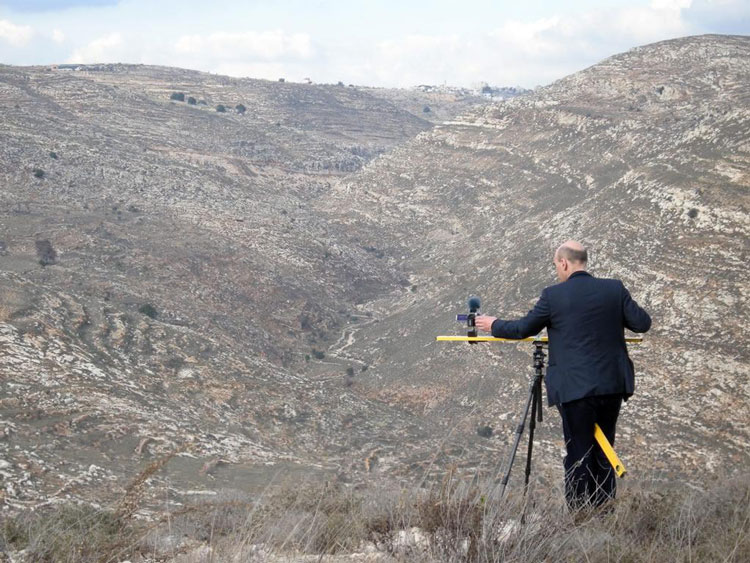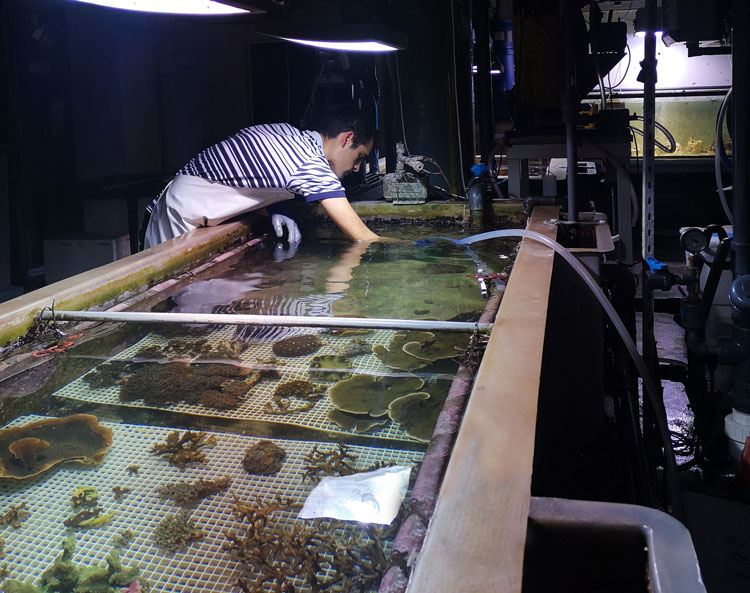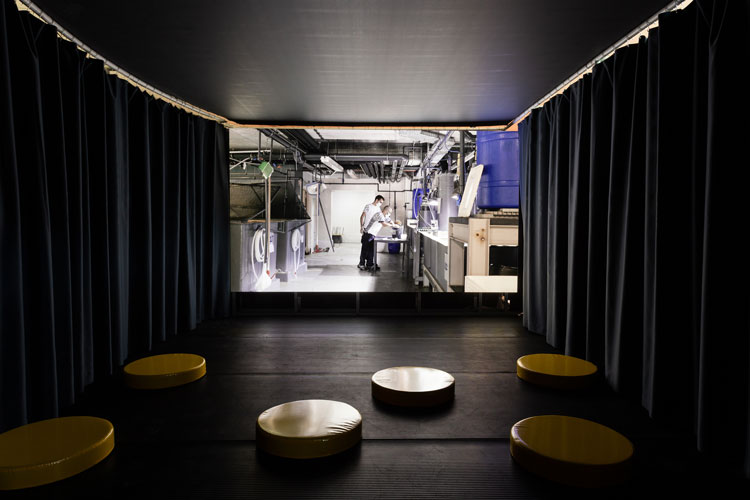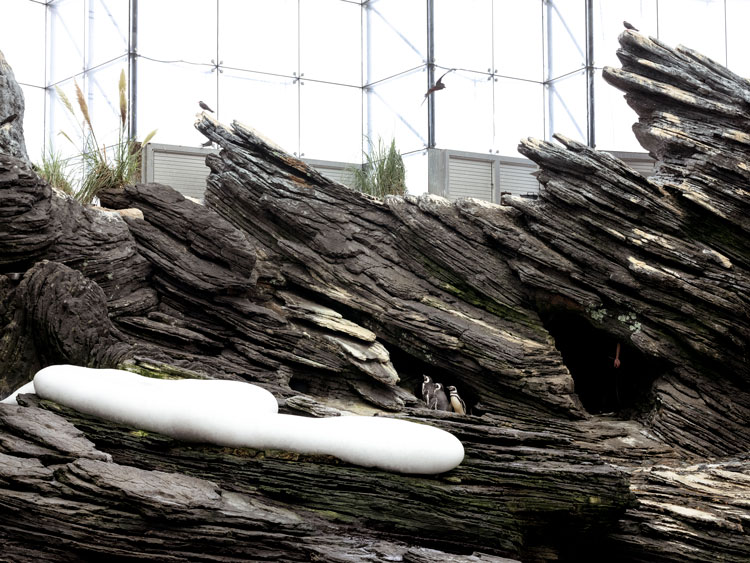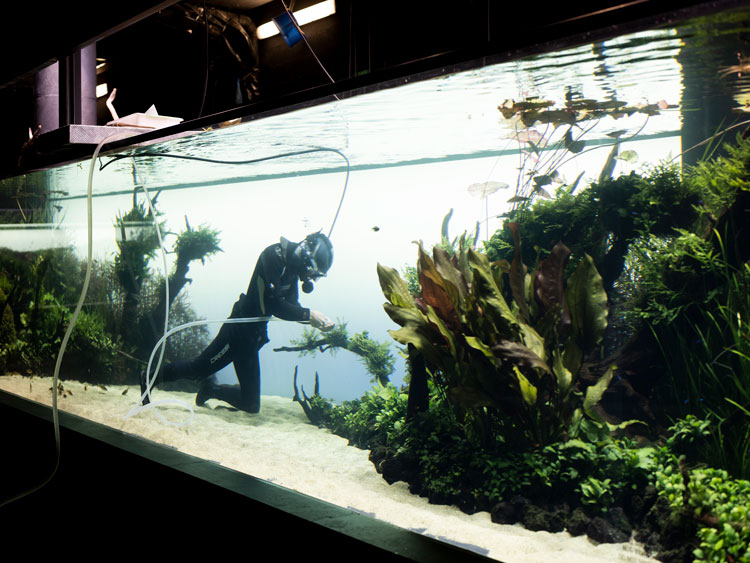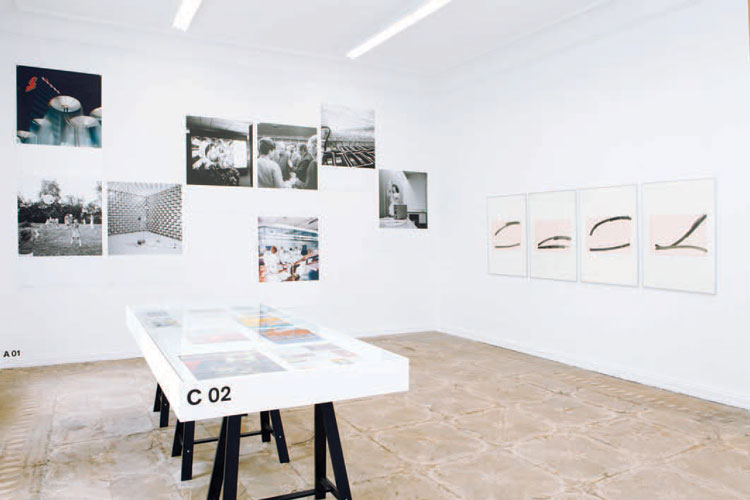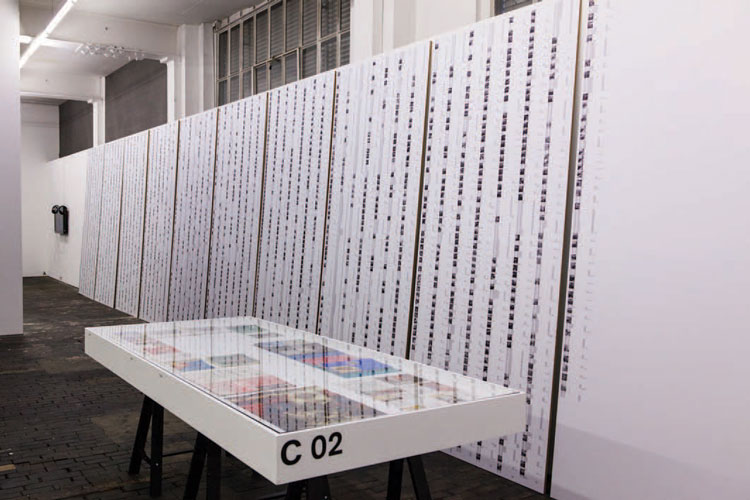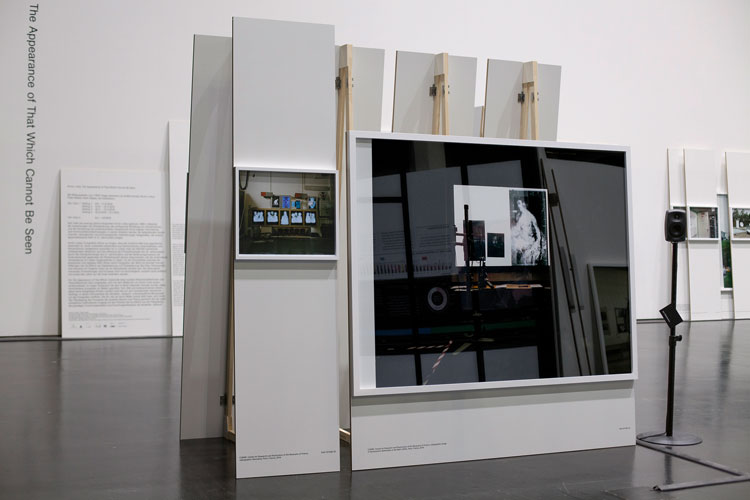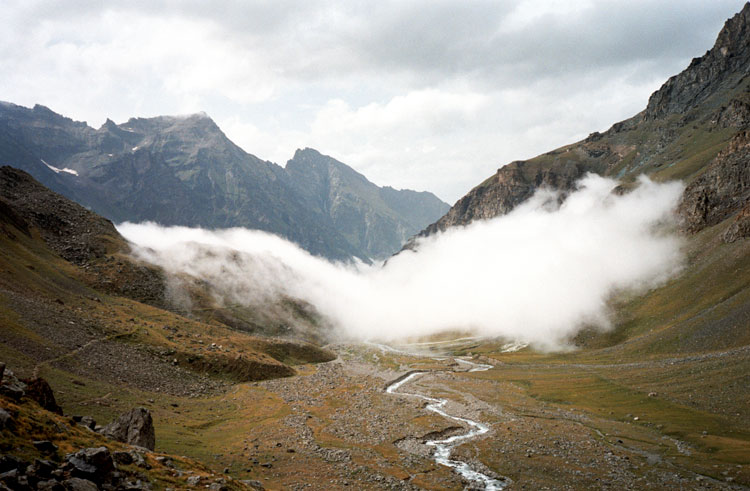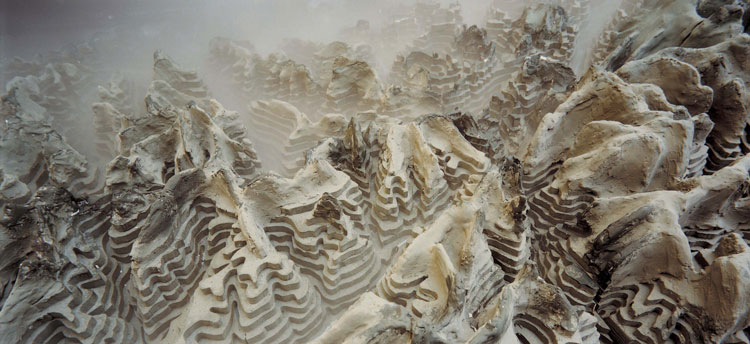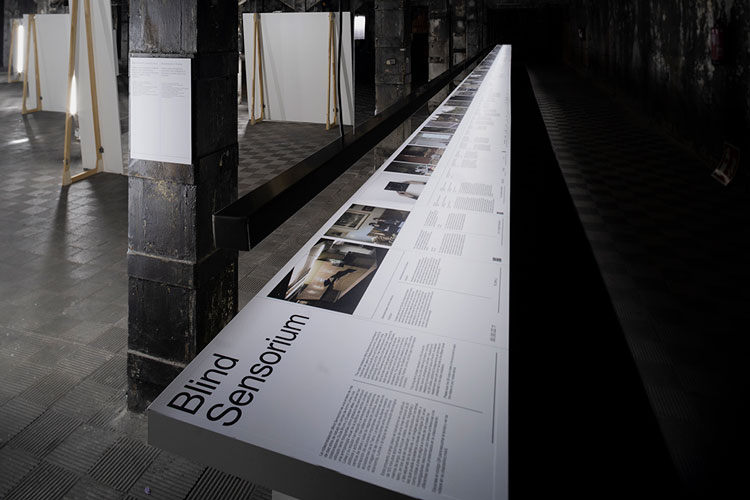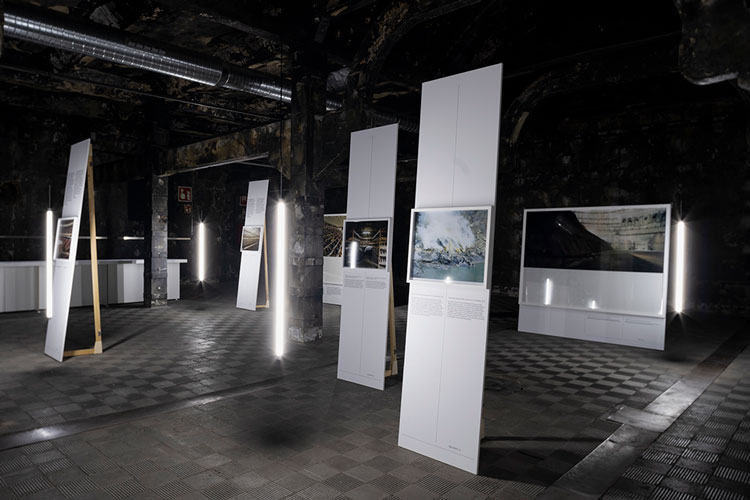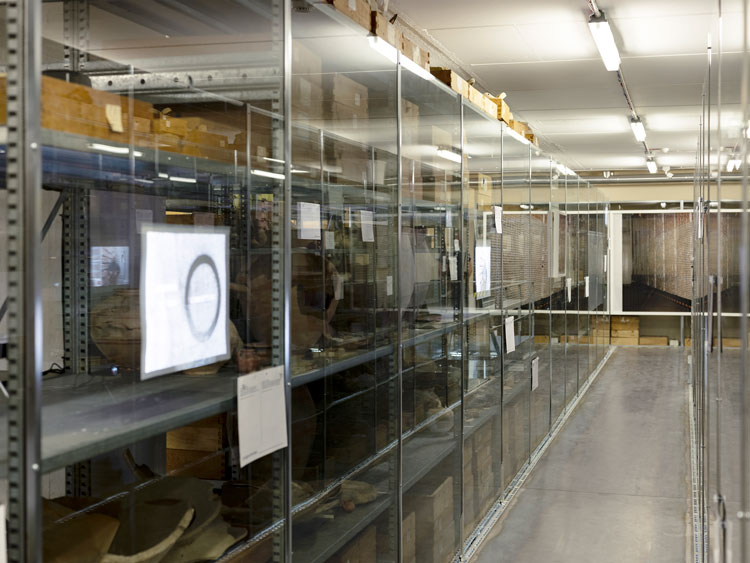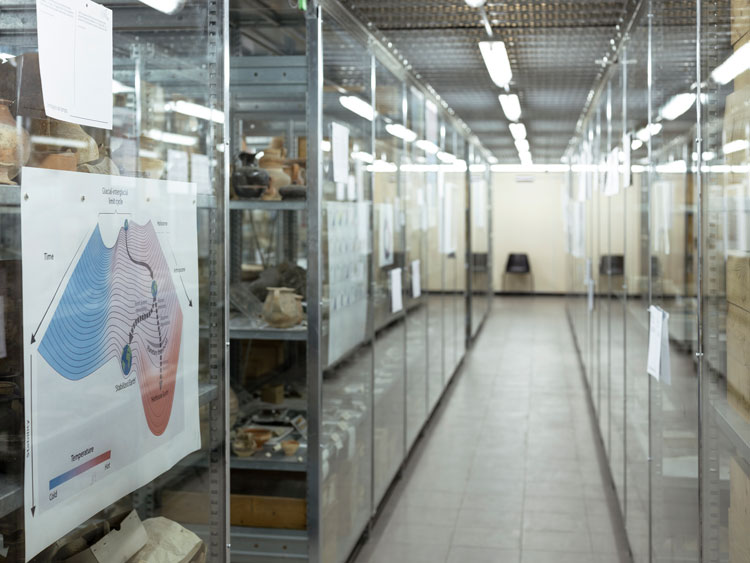

by VERONICA SIMPSON
Born in Milan in 1966, Armin Linke is a photographer and film-maker whose work incorporates geopolitics, philosophy, anthropology, science and sociology as it documents the effects of globalisation on our geographical and cultural landscapes.
His latest film was commissioned for the show AQUARIA – Or the Illusion of a Boxed Sea, curated by Angela Rui as part of a programme of three new temporary exhibitions, now showing online and at Lisbon’s Museum of Art, Architecture and Technology (MAAT). The programme was devised by Beatrice Leanza, the museum’s executive director, to bring pressing subjects concerning our future centre-stage. The film explores our relationship with the marine world and incorporates extensive behind-the-scenes footage shot at Lisbon’s Oceanarium, examining the elaborate infrastructure and scenography via which the illusion of a captive marine landscape is created.
[image3]
Linke’s practice is highly collaborative, working with a fairly consistent team of scientists, editors and sound designers. It is also iterative, with distinct strands of thought and work appearing and reappearing in evolutionary stages. Human exploitation of marine resources was also studied in depth in Linke’s Prospecting Ocean project, first shown at the headquarters of the Institute of Marine Sciences of the National Research Council of Italy in Venice in 2018. It was the result of a three-year research project in collaboration with the institute and aimed to reveal the state of health of the oceans, and also how remote-controlled underwater mapping technology is being used for the colonisation of the seabed.
Linke made the anthropocene the focus of his investigations long before the term became ubiquitous in the art world. But his focus is not just on humans’ increasing dominance over the environment, but also on how visual media and technology are shaping the way we see – and operate in - the world. He has stated that “visual media have historical consequences”, and he has sought to disrupt and interrogate the relationships of producer and audience in numerous interactive exhibition formats.
Linke, who is of dual Italian and German heritage, relocated from Milan to Berlin just over a decade ago. His work has been exhibited globally, in solo and group shows, and appears regularly at leading biennales and festivals. He has served as a research affiliate at the MIT Visual Arts Program, a guest professor at the IUAV Arts and Design University in Venice, and as a professor for photography at the Karlsruhe University for Arts and Design. He is currently guest professor at the graphic design and visual communications school ISIA Urbino in Italy.
Veronica Simpson: You have covered so much ground, geographically and thematically, in your practice. How has your artistic and academic journey evolved?
Armin Linke: At the beginning, I was not sure what to do: photography, architecture or theatre, it was between these three fields. I started in architecture, but then went into theatre, which was easy because you have unity of time and space and also the theatre is a kind of laboratory: there’s this reference between human body and the theatre set as a kind of construction.
Then I was interested in art, so I began more to document in a certain way the artistic practice. Then, maybe 25 years ago, I read in a newspaper about the construction of the Three Gorges dam in China. I thought this might be interesting to see, not just to see the construction, but also to document this piece of land art infrastructure or sculpture while including all the social consequences. At the time I was living in Milano, so, to me, it would have been like flooding Milano and all the houses and industries and universities and schools, and then reconstructing it elsewhere. What would be the whole psychological effect on the population? How could you reconstruct somehow their identity?
This then brought me to more of an anthropological approach, the anthropology of infrastructure, looking into different realms. At the same time, I was also interested in how to bring photography into the exhibition, so the photography could be a kind of performance itself, and how to bring the public into it. It brought me to creating exhibitions such as Phenotypes/Limited Forms (2003), the installation at the 50th Venice Art Biennale. (Visitors were encouraged to choose their favourite subjects from several hundred digital images on offer, rearrange them, name them, and print their own version in the form of a fanfold). It explored how the public could actively select images and put them together in a way that, now, is totally obvious (through smartphones and social media), but was not in 2003. These digital platforms were available for the first time.
[image8]
One of the last exhibitions [in which Linke re-examined the experience of photography] was The Appearance of That Which Cannot Be Seen (at Padiglione d’Arte Contemporanea, in Milan, in October 2016). There, I used photographs I had collected over 20 years and showed them to different “actors” or specialists and collected their responses. It’s a way to show photography, but not have photography as an end point. The photographer often goes to places that others don’t go, so is seen as a little bit heroic. So, then you see it as a “better” way to look at the world. But in a certain way, it’s the contrary. Photography is really not enough, but it can be a good triggering point to begin a discussion.
VS: Was this interactive curatorial approach a response to the prevailing mood in the era of the smartphone, with its extraordinary, high-definition camera? When such super-slick photography has become commonplace, photography as an art form is questioning its role in the world.
AL: Definitely. I think that in the 90s and 2000s, it really became clear that a specific path of photography was closing and this is, for example, why I developed other projects. They were mostly as part of collectives, like Double Bound Economies (first shown in 2012, at Leipzig’s Zentrum für zeitgenössische Kunst, Baumwollspinnerei, it was curated by Linke, Doreen Mende and Estelle Blaschke, who together formed the group PRODUZIEREN). We looked to the archive of industrial photographers in East Germany in the 1970s and 80s, and how they would produce images, let’s say, for the socialist system that would depict the production of the designed goods, celebrating the workers of the socialist system. But then the objects that they made could be sold in the western capitalist system. This was about looking at a photographic practice that at the time was not considered artistic but, through a rereading, says a lot about our society, our values.
[image6]
In a certain way what we have to do now is look at different categories of photography and the artistic practice is re-framing them, so that other ways of reading them are possible. Another project I was invited to work on, speaking about architecture, was by Stefano Boeri, for an architecture festival in Sardinia, I asked a friend of a friend, Corrado Calvo, who was a paparazzo, if I could see his archive of 30,000 images, mostly taken in Sardinia. I presented this to the public in a way that attracted some controversy, because my position was that the practice of Corrado Calvo, as a paparazzo (which is usually seen as the lowest form of photography, ethically) is one of the most politically or socially influential because he was asking questions about gender politics and public space. My point was, OK, let’s look at this as a cultural practice because I think in 30 or 40 years, this kind of photography will be really interesting.
Anyway, I had collected a very large photographic archive, travelling in Asia then South America, then Africa. During this process, about 15 years ago, Piero Zanini, an architect friend, said: “You’re always on the plane, travelling here and there, but all these changes of globalisation of infrastructure are happening in the Alps about 80km from Milano.” So I said, let’s make a film, but I had no idea how to make a film. At the time, there was not a high-definition video camera you could put in a backpack. It was about 2005; it is really strange to think that the technology we take for granted is not so old. We started to film different episodes, trying to look at the depiction of the landscape of the Alps, to go beyond the cliche that has been constructed for the tourism industry. It got to be an installation at the Architecture Biennale in Venice and then we developed it into a film, Alpi.
[image10]
The film basically works like a documentary, but it explains nothing. You are brought from one place to another, and you have to ask: “Am I in the next place or am I still in the other one?” You have to compare your own cliches or knowledge about the landscape with what you see. It’s also a landscape film where we just use one lens, the normal lens, not the usual wide angle you would use to convey the panorama. We never moved the camera. And you never see the landscape in the end, but you see the depiction of the landscape through scientific models or you see people negotiate about the landscape. It’s a very claustrophobic film.
Working in the Alps was easier for me because I’m half-German, half-Italian. When you work in Indonesia or China, there is always a risk that your understanding is superficial. With the Alps, we were working with Zanini, who is from Trento, so more from the north, and also Renato Rinaldi for the soundscape. And the film was edited by Giuseppe Ielasi who is a musician, not a film editor. It is a collaboration, like the film that is being presented in Lisbon.
[image2]
Maybe in Lisbon it was easier, because what we have tried to do there is to show the infrastructure that is needed to run an aquarium. The aquarium is a little bit like a model for the external world. The architecture was designed by Peter Chermayeff. We had an interview with him, because it was important before editing to hear the different viewpoints. It works like a theatre or opera, because you have the main tank, which is the stage, and the upper part, which is like the (fly tower) where the lights come in or where the scuba divers who feed the fishes come in. You have to clean the stage. They are continuously vacuum-cleaning the tanks. Of course, we are now confronted with Covid and there are all these problems of contamination. But in the aquarium, it is their problem to ensure these fishes don’t contaminate each other. There are very strict medical procedures. There is also a hospital there. Under the building, there are all the pumps and technical infrastructure. There is a Siemens computer like those used in grand hotels, which perfectly controls the microclimate: with only 1 degree of differentiation the fishes would be very disturbed. You need to control all the parameters, such as salinity, ozone and oxygen. Understanding the aquarium’s climate helps you to understand how our microclimate is very sophisticated.
Then you have geopolitical issues, because you see they are filling the water with salt and the salt comes from the Red Sea. For us, it was important also to work with the curator, Angela Rui, because she did a lot of the pre-research on the history of the aquarium (the Lisbon Oceanarium, which opened in 1998 in the grounds of that year’s World Expo in Lisbon). Having access to her briefing and her research was very interesting. For example, this tank is a kind of World Expo in itself because all these fishes come from four or five oceans and are presented as a kind of United Nations of fishes. But this is also a kind of fiction. There is another tank where you have only plants and this is run by a group of artists and designers from Japan. The water quality is continually monitored, and there are two laboratories just for this. You have a sushi restaurant so each fish has its own menu, and some of them have scuba divers going down every day or every two days to feed them. You have very strict procedures. This is also a model of our own world only we are not aware of it. Then you have also other aspects we tried to film: for example, all the aquariums and zoos of the world have software by which they are connected, so they can exchange information. There is a whole economy of animal life between these different centres.
We could only film there for two weeks, which was complicated during Covid. But it was nice that the aquarium staff trusted us, showed us areas that are not accessible to the public. It’s like a magician who also shows the back stage of how you recreate life. It’s the aquarium as a place almost of divinity, where you create a whole life ecosystem.
VS: Absolutely and, as consumers, we usually experience the aquarium in a semi-miraculous way, as a window on to a world we shouldn’t be able to view from our air-breathing, land-based perspective. So you are breaking the fourth wall, showing how it’s done.
AL: Yes, it’s a really Brechtian thing to make people aware of the process. That’s also something I learned in my collaboration with [the French philosopher and anthropologist] Bruno Latour. I collaborated with him on another exhibition, Appearance (The Appearance of That Which Cannot Be Seen).You are a film-maker, but you are also an anthropologist of such and such an infrastructure. And what is interesting, infrastructure like this can be a model of our external world. It’s a fiction, but it can be a model for our reality, and for negotiation. How many people do you allow to go in? How do you regulate all this? Which kind of fish can survive or are compatible with captivity? There are so many negotiations in this.
VS: This fits into the context of the overall exhibition at MAAT, which is trying to show how our idea of nature is entirely constructed?
AL: Yes. It opens up questions. Of course, all these fishes are in captivity in this artificial world, but do we have the right to keep them there? It is a completely surreal situation; there is something grotesque in it.
VS: What impact do you hope seeing this film will have on people?
AL: Understanding that this idea of nature is a cultural construction. Even the forests that we think of as eternal, we can see are often a human construction. The aquarium is an example of how we need to negotiate what we consider nature. And, of course, an aquarium is a place of consumption. You consume an experience.
VS: It’s fascinating, to me, that you have resources to make this kind of work – some of it involving years of research. How do you find support for all the research-intensive and time-consuming work?
AL: I don’t know how other artists work, but I have a kind of wish list, while I continue in different projects. There are also different wish lists, and then you encounter somebody like Angela Rui, who is working on it and maybe she saw other works of mine and says that would be interesting, and then a collaboration starts.
[image11]
VS: I like the idea of wish lists. What is top of your wish list for 2021?
AL: I am preparing another exhibition with Estelle Blaschke, a historian of photography. We worked together on Double Bound Economies. This is called Image Capital and is about the history of photography. Estelle has long researched how the concept of digitalisation started in 1910 or 1920 when Kodak began to market microfilm commercially in 1928. It was used mostly in the beginning to photograph cheques. In a certain way, we want to look at the history of photography through operative photography. This was the first photography used to create large datasets. That is on my wish list. We would like to look at how image recognition is used in agriculture; also, the history of photography in physics and astronomy. We would like to look at artificial intelligence. Now we have a little wish list and we will try to go to these places in the next year. Many of the projects are growing in time. Some of them are really complicated so at the beginning you don’t have the knowledge. You need some years of research. There is an exhibition right now in Madrid, at The Matadero (Blind Sensorium: Visual Anthropology) which looks at that evolution.
[image12]
VS: It goes back over the years, looking at the questions you were asking with your first travel assignments, like the one in China.
AL: Yes, but I didn’t have a cultural term such as “the Anthropocene” with which to present my own work then. A lot of projects are constructed through sub-projects in time and you learn by doing, but also you accumulate, you split up the complicated production issues in more steps. For the project now in Lisbon, it was very important to work with Giulia Bruno, my long-term collaborator. She has a degree in biology. It was very important for me so that when we enter a lab, I can say: what are they doing here? I can ask her to speak with the scientists. Or for the editing, working with Giuseppe and having this sound part is very important. On the intellectual side also, collaboration is very important. Because some of the issues are so complicated you really need collective knowledge around them.
VS: Would you say the interest in the field you have made your own has grown – analysing the human impact on our landscapes and what that says about our culture and values?
AL: It’s difficult to say in lockdown. Definitely there is an interest, yes. On the other side, maybe I’m always a bit afraid that everyone is fixing on a topic and the next one is out of focus. It is important to ask whether artists should try to give voice to topics or groups or issues that are not on the radar yet. The topic of the anthropocene is in front of us now. And(the impact) are becoming more and more visible. We can’t escape, regardless of what we want and don’t want as artists or practitioners.
VS: Is there not scope to agitate against this fatalism or dystopian vision? After all, art gives us an opportunity to imagine things differently.
AL: My father was an industrial designer. So, I mean, maybe it’s important that these questions are asked in the engineering and design and marketing schools now, because they are designing the future of consumption.
• AQUARIA – Or the Illusion of a Boxed Sea is at the Museum of Art, Architecture and Technology (MAAT), Lisbon until 6 September 2021.
A retrospective exhibition of Linke’s work, Blind Sensorium: Visual Anthropology, is at Matadero Madrid, until 20 May 2021.
